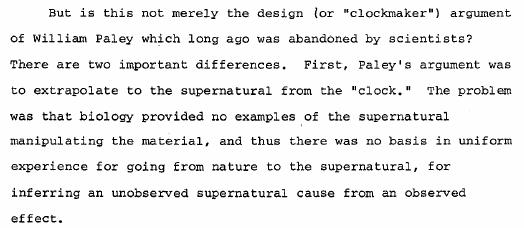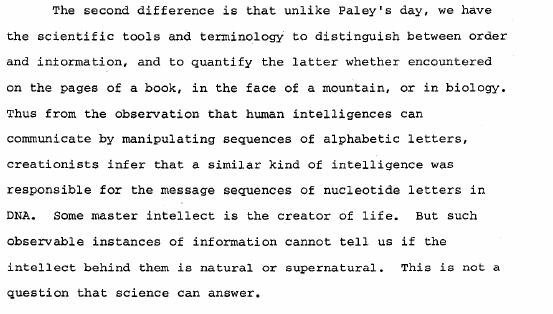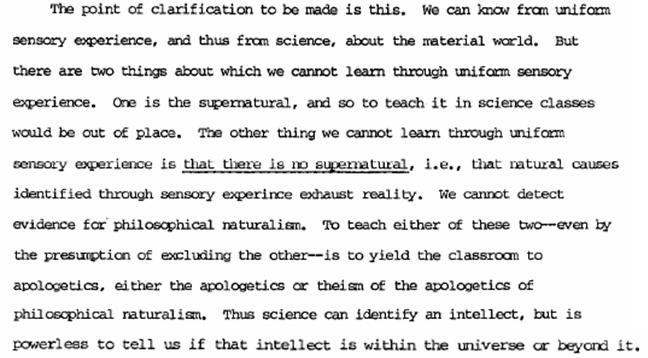What’s Up with Ronald Numbers? An Analysis of the Darwinist Metanarrative in the Journal of Clinical Investigation
Published at Evolution News[Editor’s note: this article originally appeared as a series of three posts on Evolution News & Views at the following links—Part I, Part II, Part III. The article has been slightly edited from the original posts to allow for a single article which smoothly captures the arguments of the original three posts.]
Introduction
Ronald Numbers is a widely respected historian of science. He is an exceptional scholar who has garnered the respect of people on all sides of this debate. However, a recent article in the Journal of Clinical Investigation, “Defending science education against intelligent design: a call to action,” co-authored by, among others, Ronald L. Numbers, Elliot Sober [anti-ID philosopher], and Terese Berceau [anti-ID legislator], gives one pause to wonder if Numbers is shifting his role from commentator, to partisan.
In a twist unexpected from the scholarship of Dr. Numbers, the article launches into polemics using invective language:
“After the Edwards ruling [Edwards vs. Aguillard, 1987], they set about removing references to God and creationism from their tracts.” (Defending science education against intelligent design: a call to action, emphasis added)
Such emotive language is not commonly found in scholarly journal articles. A “tract” is “A leaflet or pamphlet containing a declaration or appeal, especially one put out by a religious or political group.” To compare ID literature, such as William Dembski’s Cambridge University Press The Design Inference, or Stephen Meyer’s paper published in Proceedings of the Biological Society of Washington to “tracts,” “leaflets,” or “pamphlets” with purely religious or political language is out of character for an article in a scholarly journal, and out of character for Ronald Numbers.
Is William Dembski’s peer-reviewed, Cambridge University Press-published, academic monograph The Design Inference a mere religious “tract”? What about Stephen Meyer’s peer-reviewed critique of natural selection’s ability to create new genetic information, and his closely reasoned argument in the same essay that intelligent design is the only presently acting cause of information and, therefore, the best explanation for the quantum increase in biological information during the Cambrian explosion, an argument that draws heavily on his extensive training in the history and philosophy of science (Ph.D., Cambridge University), and carefully reviews all of the leading materialistic hypotheses for the Cambrian explosion, including structuralist and self-organizational models? Does labeling these two works “tracts” answer the arguments these two scholars put forward? Will other labels work the same rhetorical magic—”garbage,” “bilge,” “doo doo”? If so, is this why they offered no substantive critique of the central arguments made by Dembski and Meyer? I mean, why bother to engage in close, reasoned debate when a quickie label like “tracts” can make all of your opponent’s pesky arguments disappear.
Apart from using polemics, this article recapitulates the standard Darwinist metanarrative about ID, which goes something like this:
“ID is just an evolved version of creationism where creationists got smart and took out the word “God” to avoid a legal decision, but in reality it’s just an untestable appeal to the supernatural, which says that if evolution cannot explain some things, then therefore it must have been created by miracles from a supernatural or divine being: that claim isn’t testable, and therefore isn’t science, and that’s why ID has never published any peer-reviewed work supporting its ideas. ID is nothing but religion, and cannot contribute anything to science other than stopping otherwise fruitful research. ID proponents should stop trying to push it into the classroom because ID threatens science education, science, and the security of our future.”
But is this metanarrative true, or is it simply another Darwinist creation myth? This response will track how this article makes each claim in the Darwinist metanarrative, and will argue that each claim is false. An elaboration of each inaccuracy will be delivered below.
Inaccuracy #1
The article claims to be inspired by a desire “to address the attempts to undermine science education in Wisconsin.” That made me suspicious because I know of no group in Wisconsin that is trying to undermine evolution education, or, as the metanarrative states, to push ID into the classroom. The authors hold such an opinion, but again, such polemics are unexpected in a scholarly journal article. The article claims:
“In 2004, the school board of Grantsburg, Wisconsin, voted to have ID taught as an alternative scientific theory to evolutionary theory.” (Defending science education against intelligent design: a call to action)
The problem is that this is just flatly wrong. Here’s what Grantsburg’s policy actually says:
“Students are expected to analyze, review, and critique scientific explanations, including hypotheses and theories, as to their strengths and weaknesses using scientific evidence and information. Students shall be able to explain the scientific strengths and weaknesses of evolutionary theory. This policy does not call for the teaching of Creationism or Intelligent Design.”
There is an easy test to determine if Grantsburg’s policy is really teaching ID: observe Darwinist behavior. It took the ACLU less than 2 months to file a lawsuit to have intelligent design banned from Dover, Pennsylvania biology classrooms. If Grantsburg had included ID, we would have immediately seen a lawsuit against the Grantsburg district. But there has been no lawsuit. Why? Because critical analysis policies like this one have nothing to do with ID.
Inaccuracy #2
The article states that the removal of the phrase “creationism” from the textbook Of Pandas and People implies that ID is just creationism “mutated” over:
“The creationists once again mutated and adapted. After the Edwards ruling, they set about removing references to God and creationism from their tracts. For example, as revealed at the Dover trial (8), the authors of the intelligent design (ID) text Of pandas and people: the central question of biological origins stripped the direct mentions of creationism present in early drafts of the text and systematically substituted the novel term ‘intelligent design'” (Defending science education against intelligent design: a call to action)
Is there more to the story? When certain pre-publication drafts of Pandas used terms such as “creation” and “creationist,” they used them in a way that rejected “creationism” as defined by the courts and popular culture. In Edwards v. Aguillard, the U.S. Supreme Court declared creationism to be a religious viewpoint because it required a “supernatural creator”:
The legislative history therefore reveals that the term “creation science,” as contemplated by the legislature that adopted this Act, embodies the religious belief that a supernatural creator was responsible for the creation of humankind. (Edwards v. Aguillard, 482 U.S. 578, 591-592, emphasis added)
Thus, what the Supreme Court found was religion and therefore unconstitutional was not the word “creationism,” but the teaching that a “supernatural creator” was responsible for life. “Creation science” was how the Louisiana Legislature had used to describe that religious concept.
Yet pre-publication drafts of Pandas juxtaposed the word “creation” with statements to the exact opposite effect, noting that science cannot scientifically detect a supernatural creator. Consider these important excerpts from pre-publication drafts of Pandas, showing that from the beginning, their project did not do what made traditional “creationism” unconstitutional: it did not delve into supernatural explanations:



In each of these excerpts from pre-Edwards v. Aguillard drafts of Pandas, it is clear that the idea of “creation” discussed in pre-publication drafts of Pandas was specifically NOT trying to postulate a supernatural creator! The concepts advanced by even pre-publication, pre-Edwards drafts of Pandas were sharply different from what the courts have defined as “creationism.” These early drafts were not trying to study the supernatural.
To solidify this point, consider the deposition testimony of Charles Thaxton as to why he started to use the term intelligent design in the Pandas book:
I wasn’t comfortable with the typical vocabulary that for the most part creationists were using because it didn’t express what I was trying to do. They were wanting to bring God into the discussion, and I was wanting to stay within the empirical domain and do what you can do legitimately there.
Deposition of Charles Thaxton 52-53, Kitzmiller, No. 4:04-CV-2688 (M.D. Pa., July 19, 2005).
Similarly, a 1990 post-publication rebuttal to a critic, written by the Pandas publisher explains:
As a consequence, yes, we are careful not to identify the intelligent cause behind the biological phenomena presented, but not for purposes of stealth, but rather precisely because we think that this is a religious conclusion.
Thus, the limits of what intelligent design can tell us stem not from legal strategies but from an honest effort to limit statements to scientific claims that can be made based upon the empirical data. ID is about respecting the limits of the scientific data—not hiding religion for legal purposes. In other words, even in its pre-publication form Pandas offered a theory that was conceptually distinct from what the courts have defined as “creationism.”
The authors of the article are wrong to say that ID “mutated” to avoid a court decision. ID was formulated in its present form—an empirically based argument that would not stray into the supernatural—before the Edwards case was decided. Thus, even before Edwards v. Aguillard, ID lacked the very quality that caused creationism to be declared unconstitutional: it did not postulate a “supernatural creator.”
Inaccuracy #3
The article states that Kansas now includes the supernatural in its state standards’ definition of science:
Even the definition of science itself has fallen victim to political attack; the state board of education in Kansas decided that the supernatural may now be taught as science in the classroom.
That is a false statement. The new Kansas science standards simply re-set their definition of science back to how approximately every other state in the country defines science, essentially the way Kansas had defined it until 2001, as a way of knowing that investigates the natural world through the use of observation, experimentation, and logical argument, and makes only testable hypotheses:
Science is a systematic method of continuing investigation that uses observations, hypothesis testing, measurement, experimentation, logical argument and theory building to lead to more adequate explanations of natural phenomena. Science does so while maintaining strict empirical standards and healthy skepticism. Scientific explanations are built on observations, hypotheses, and theories. A hypothesis is a testable statement about the natural world that can be used to build more complex inferences and explanations. A theory is a well-substantiated explanation of some aspect of the natural world that can incorporate observations, inferences, and tested hypotheses. Scientific explanations must meet certain criteria. Scientific explanations are consistent with experimental and/or observational data and testable by scientists through additional experimentation and/or observation.(2005 Kansas Science Standards, p. 10, emphasis added)
When the Darwinists took over the Board of Education in 2001 and defined science as “seeking natural explanations,” Kansas became the only state in the United States to explicitly advocate for hard-code methodological naturalism into its state science standards. Thus, the new Kansas standards (2006), by removing such language, moves closer to the norm for U.S. science standards.
There is a great irony in the fact that this article criticizing the Kansas science standards was co-authored by Wisconsin State Representative Teresa Berceau (D). Ms. Berceau submitted a bill to the Wisconsin legislature that she thinks outlaws ID because the bill requires that material taught as science be “testable as a scientific hypothesis.” Ignoring for the moment the fact that ID is testable, the article’s assertion on this contradicts Berceau’s own logic: she thinks ID is an untestable supernatural explanation, so she submitted a bill that she thinks will outlaw ID because the bill requires that all science taught must be “testable as a scientific hypothesis and describes only natural processes.” Yet in the article discussed here, she claims Kansas’s definition of science includes the supernatural despite the fact that testability is a strong thread throughout Kansas’s definition of science (see emphasized portions above). Berceau making contradictory arguments, and she is doubly wrong: Not only is ID not outlawed by her bill (because ID is indeed testable and doesn’t invoke the supernatural) but the Kansas science standards nowhere incorporate the supernatural.
Here’s a question I submit to Berceau and all proponents of the false conspiracy theory that Kansas now teaches the supernatural in science classes: if Kansas incorporated the supernatural into its definition of science, then how do you explain the fact that its science standards emphatically require that all science be testable?
…This leads us to the next and perhaps most important inaccuracy in the Berceau/Numbers article:
Inaccuracy #4
The article makes various false statements that ID postulates a supernatural creator and is untestable: “ID and its progeny rely on supernatural explanations of natural phenomena,” and “ID makes no testable predictions. There is nothing in this concept that allows for scientific investigation of the ‘designer.’ It is simply an argument by default; the failure to explain something is said to lend credence to a supernatural explanation.”
These quotations recapitulate the Darwinist metanarrative at its best. Yet the writings of ID proponents make it clear that these statements are completely false:
- ID does not require supernatural causation because to do so would go beyond the limits of scientific inquiry.
- ID is not merely a negative argument against evolution; and
- ID makes testable predictions.
Indeed, the very text Of Pandas and People, the supplemental biology textbook Numbers and his co-authors claim demonstrates that ID is creationism, instead makes clear that it does not rely upon supernatural causation and shows that ID makes positive arguments:
If science is based upon experience, then science tells us the message encoded in DNA must have originated from an intelligent cause. But what kind of intelligent agent was it? On its own, science cannot answer this question; it must leave it to religion and philosophy. But that should not prevent science from acknowledging evidences for an intelligent cause origin wherever they may exist. This is no different, really, than if we discovered life did result from natural causes. We still would not know, from science, if the natural cause was all that was involved, or if the ultimate explanation was beyond nature, and using the natural cause.
(Of Pandas and People, p. 7, emphasis added)
Oddly, the article also states that ID proponents “conveniently omi[t] mention of God.” Call this the opposite-arguments-regarding-ID-and-the-supernatural fallacy: You cannot critique ID because it requires “rel[ies] upon supernatural explanations” and then on the other hand critique it for allegedly cleverly removing references to the supernatural (i.e., God). Darwinists can’t criticize ID on the one hand because, as they claim, it does identify the designer as supernatural, and then on the other hand because it doesn’t.
What does ID actually do? ID shows appeals to our uniform experience of presently acting causes to show that certain features of the natural world are best explained by reference to intelligent design rather to some purely material cause like Darwinian natural selection. This is a program of inquiry that can be undertaken apart from religious questions about the supernatural.
Contrary to what the articles says, ID proponents do not “conveniently omi[t] mention of God.” Consider how Michael Behe has explained that, while he does believe in God, the scientific data from biology do not allow one to tell if the designer is God or even whether the designer is supernatural:
The most important difference [between modern intelligent design theory and Paley’s arguments] is that [intelligent design] is limited to design itself; I strongly emphasize that it is not an argument for the existence of a benevolent God, as Paley’s was. I hasten to add that I myself do believe in a benevolent God, and I recognize that philosophy and theology may be able to extend the argument. But a scientific argument for design in biology does not reach that far. Thus while I argue for design, the question of the identity of the designer is left open. (Michael Behe, “The Modern Intelligent Design Hypothesis,” Philosophia Christi, Series 2, Vol. 3, No. 1 (2001), p. 165, emphasis added.)
Thus Behe is open about the fact that he believes that the designer is God. I, too, believe in the same God that Michael Behe believes in. But these are our religious beliefs, which are not derived from the scientific claims of intelligent design. Many ID proponents may share our view that the designer is God (though some do not), but that belief is not derived from ID theory.
Behe’s characterization of intelligent design is consistent with what the early pre-publication drafts of Of Pandas and People stated, as well as what the published version stated:
[S]cientists from within Western culture failed to distinguish between intelligence, which can be recognized by uniform sensory experience, and the supernatural, which cannot. Today we recognize that appeals to intelligent design may be considered in science, as illustrated by current NASA search for extraterrestrial intelligence (SETI). Archaeology has pioneered the development of methods for distinguishing the effects of natural and intelligent causes. We should recognize, however, that if we go further, and conclude that the intelligence responsible for biological origins is outside the universe (supernatural) or within it, we do so without the help of science.” (Of Pandas and People, a pro-ID textbook, pp. 126-127, emphasis added)
Ronald Numbers and his colleagues misunderstand intelligent design and are misrepresenting it to the public. I am surprised that a historian such as Numbers would have added his name to this article.
Inaccuracy #5
The article states that “Behe assumes that the component parts of irreducibly complex systems never had other functions in older organisms.” This false claim, made by the Dover plaintiffs and then repeated by Judge Jones, was refuted by Part I of my April, Do Car Engines Run on Lugnuts? post, noting that Behe (and others) have devoted much discussion to the inadequate argument that the presence of other functions for a given part of an irreducibly complex system undermines a claim of irreducible complexity.
Inaccuracy #6
The article also implies that ID has published no studies about how life came about:
However, those studies tell us a great deal about how life came to be as it is and now form the foundation of modern biology. ID, by contrast, has produced nothing.
This common fallacious claim is easily refuted by a listing of peer-reviewed articles and books, some published in highly prestigious venues, supporting ID.
Most importantly, this literature is helping us to understand the natural world. As Stephen Meyer explains in his peer-reviewed article, ID helps us to understand the origin of biological information:
Analysis of the problem of the origin of biological information, therefore, exposes a deficiency in the causal powers of natural selection that corresponds precisely to powers that agents are uniquely known to possess. Intelligent agents have foresight. Such agents can select functional goals before they exist. They can devise or select material means to accomplish those ends from among an array of possibilities and then actualize those goals in accord with a preconceived design plan or set of functional requirements. Rational agents can constrain combinatorial space with distant outcomes in mind. The causal powers that natural selection lacks—almost by definition—are associated with the attributes of consciousness and rationalitywith purposive intelligence. Thus, by invoking design to explain the origin of new biological information, contemporary design theorists are not positing an arbitrary explanatory element unmotivated by a consideration of the evidence. Instead, they are positing an entity possessing precisely the attributes and causal powers that the phenomenon in question requires as a condition of its production and explanation. (Intelligent Design: The Origin of Biological Information and the Higher Taxonomic Categories by Stephen C. Meyer, Proceedings of the Biological Society of Washington, 117(2):213-239 (2004).)
And the ID explanation can also yield fruitful insights into biology. Pro-ID biologist Jonathan Wells has suggested in a peer-reviewed ID journal that intelligent design can help us to understand function of Junk-DNA:
Since non-coding regions do not produce proteins, Darwinian biologists have been dismissing them for decades as random evolutionary noise or ‘junk DNA.’ From an ID perspective, however, it is extremely unlikely that an organism would expend its resources on preserving and transmitting so much ‘junk.’” (Jonathan Wells, “Using Intelligent Design Theory to Guide Scientific Research,” Progress in Complexity, Information, and Design, Vol 3.1, Nov., 2004.)
Wells’s approach might have helped us to avoid pitfalls stemming from Neo-Darwinian thought. For example, a widely used college textbook on molecular biology leads students to believe that, under Neo-Darwinian thinking, introns are merely genetic junk:
Unlike the sequence of an exon, the exact nucleotide sequence of an intron seems to be unimportant. Thus introns have accumulated mutations rapidly during evolution, and it is often possible to alter most of an intron’s nucleotide sequence without greatly affecting gene function. This has led to the suggestion that intron sequences have no function at all and are largely genetic “junk”… (Molecular biology of the Cell, 3rd Ed. (1994) by Bruce Alberts, Dennis Bray, Julian Lewis, Martin Raff, Keith Roberts, and James D. Watson)
That Darwinist statement was written in 1994. In 2003, an article in Scientific American about the functionality of so-called “junk-DNA” called our failure to recognize introns as functional within the cell “one of the biggest mistakes in the history of molecular biology”:
Yet the introns within genes and the long stretches of intergenic DNA between genes, Mattick says, “were immediately assumed to be evolutionary junk.”
[…]
About two thirds of the conserved sequences lie in introns, and the rest are scattered among the intergenic “junk” DNA. “I think this will come to be a classic story of orthodoxy derailing objective analysis of the facts, in this case for a quarter of a century,” Mattick says. “The failure to recognize the full implications of this—particularly the possibility that the intervening noncoding sequences may be transmitting parallel information in the form of RNA molecules—may well go down as one of the biggest mistakes in the history of molecular biology.” (The Unseen Genome: Gems Among the Junk by Wayt T. Gibbs, Scientific American (November, 2003), emphasis added.)
Intelligent design leads us to the testable expectation that designers make things for a reason—and thus ID leads us to expect that structures in biology probably have some function. Had scientists considered an ID approach, the mistake Mattick so passionately identifies could have been avoided.
Conclusion
The article by Numbers and his co-authors nicely encapsulates the Darwinist metanarrative about ID. A close analysis exposes that this metanarrative—though widely promulgated—is factually bankrupt.
Sadly, the article also uses harsh invectives and polemics to describe ID. These are surprising for an article appearing in a scholarly journal. Given the prestige garnered by co-author Ronald Numbers for his past works on the history of this debate, one cannot help but ask, “Has Numbers given up his role as historian and become a partisan in the debate?” Is Professor Numbers maintaining his neutrality, or is this polemical and factually-challenged article a departure from his position as an academic historian of science?
